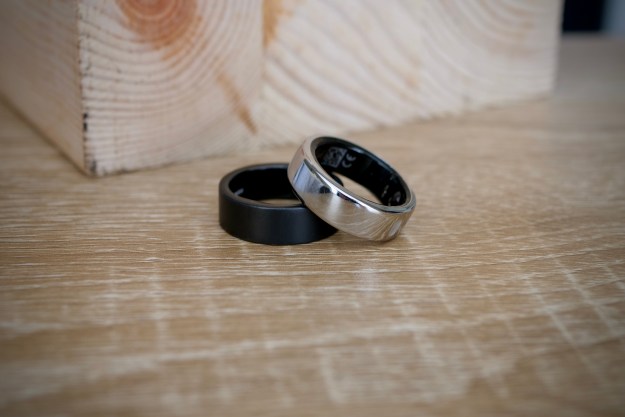It has been almost a year since we first saw TechNovator’s XE wireless charging station powering up a smartphone wirelessly from across the room. Back then, the prototype was a huge mess of wires and the power transmitter was huge. Today at IFA in Berlin, we saw the latest version of TechNovator XE, a power router with a stylish, twisted design powering up an iPhone 6, wearing what looked like an ordinary battery case.
“We would like to find out how much consumer demand there is for this product,” TechNovator CTO, Ivan Chuba, told Digital Trends.
Remote wireless charging has the potential to be a real game changer for the industry. Battery life is still a major bugbear for consumers. There’s no doubt that it would be much more convenient if our devices charged automatically without us having to lift a finger. We think this kind of technology could be a major attraction for consumers, but nothing has hit the market yet, so it’s tough to gauge interest.
The wireless power transmitter is quite large, but most of the clever stuff is happening in the base cube, the top two thirds or more is an aerial for broadcasting the low-frequency electromagnetic waves that carry the power. We like the twisted helix design, but it is a pretty big device. TechNovator also showed us an alternative design for the power transmitter that attached the base unit to a picture with the aerial hidden within it. Inventive thinking like this will help wireless power transmitters blend into different environments and quietly do the job.
Remote wireless charging has the potential to be a real game changer for the industry
For your device to charge up, it needs a receiver with a decent surface area to catch the waves. The first receiver design is a thin card, the exact dimensions of the back of the iPhone 5. The card is designed to show how the technology might be assimilated directly into future smartphones. TechNovator has changed tactics slightly since then and developed an iPhone 6 case, which is about the same size as a typical battery case and has an integrated receiver.
It takes a second or two after you turn the transmitter on for the receiver to connect and start charging your device. We tested at around 8 feet, which is all the show floor would allow, but the XE is capable of carrying a decent amount of power as far as 17 feet away. TechNovator is still hard at work on improving the efficiency. The further you move from the transmitter, the slower the charge. The charging rate is slower than a wired connection, but not far behind the current popular wireless charging standards which require contact, typically through a mat.
The XE can also charge up multiple devices simultaneously. They charged four of the prototype receivers at once during the demo, which is great. Truly wireless charging like this could eliminate arguments over outlets and charging pads.
The TechNovator XE can charge through thin materials as well, so it could charge up the smartphone in your pocket or bag. However, there are limitations. The electromagnetic waves won’t pass through walls or water. If the transmitter is blocked by a human body or you walk into the next room, the charging will stop. Chuba assured us that the technology is safe and no different than the waves we are already exposed to on a daily basis. TechNovator has conducted extensive testing in this area, and they will obviously have to go through FCC approval ahead of a U.S. launch.
You can get some feedback and fine control over the XE through the companion app, which allows you to set charging intensity to low, medium, or high. The lower you set it, the slower the charge, but this is better for the long-term health of the battery, so that’s why you have that option. There’s also a nifty auto-charge feature, so that you can dictate when charging should start. You can have it kick in automatically when your battery drops below a certain point or falls within a specific range.
Although many people might like the idea of remote wireless charging in the home, it could prove to be most useful when we’re out and about. It’s often impossible to plug in when we’re in public places, and wireless charging mats haven’t really been adopted very widely. TechNovator’s XE could be a really good fit here.
“The XE technology could be implemented in hotels and restaurants, so people might search for a power signal, the way they search for Wi-Fi right now,” suggests Chuba. “Wi-Fi is a higher frequency and we’re using a lower frequency, so there’s no overlap or interference.”
We can attest that this certainly appears to be true because the demo worked perfectly on the busy show floor at IFA, which is a hive of Wi-Fi activity.
As soon as a major manufacturer adopts technology like this and puts it into a smartphone or another device, we’ll see how attractive it really is to consumers. The idea clearly has a long history and TechNovator is not the only company exploring remote wireless charging.
We also spoke to a potential competitor for TechNovator at IFA this year, a U.S. company called Energous, which was showing off a reference design for a wireless power transmitter that could plug into a wall charger or laptop and charge up small wearables, like earphones, fitness trackers, or hearing aids.
Energous also has a larger version for smartphones, but we haven’t seen it in action yet. The company signed an exclusive deal with a big manufacturer and the spokesperson suggested that products will be ready in time for CES at the beginning of 2017.
TechNovator is holding meetings at IFA with some case makers and device manufacturers, including Samsung. Their aim is to hone the charging range and improve efficiency ahead of a launch next summer. They estimate an entry price of around $250, which would buy you a power transmitter and a case for your phone.
It’s great to see how far TechNovator has come in under a year with a small, hard-working, and clearly passionate team. We’re be keeping a close eye on how things develop. In the meantime, you can find out more at the TechNovator website.
Editors' Recommendations
- Otterbox’s Folding Wireless Power Bank offers fast charging while gaming
- GuRu’s robot could charge up your devices wirelessly over a distance
- Mophie’s latest wireless chargers let you charge all your Apple devices at once




